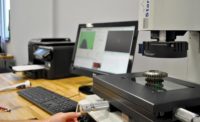If you are looking to quickly create ballooned drawings and first article inspection documents, you need the right tools for the job.
As any quality professional knows, tools can make your work infinitely easier—or slow you down. Whether it’s an automated inspection system or eliminating manual data entry, there are a myriad of ways that quality tasks can be done faster and more accurately.
And a big part of it is software. Real-time data collection, for example, has improved quality for the better, as companies can now track defects as they happen, or prevent them from happening in the first place. Another key example is keeping track of data, specifically inspection results. Once you’ve used a new solution, it can be difficult to imagine how you ever functioned without it.
That may be the case if you’ve recently moved from manual data entry to a software system to handle your data. Quality is difficult enough, and it may seem more challenging if your industry requires compliance to various standards, as in aerospace. But ensuring compliance with AS9102, PPAP, or Part 820 doesn’t have to be a slog.
According to SAE, AS9102 requires first article inspection in order to document the quality of aerospace components. The organization states, “It is intended that the documentation generated will be a quality record of the supplier and customer for review of accountability and planning, for performing periodic surveillance and audits to verify conformance, for evaluating root cause and corrective action for any non-conformances, and for problem investigations.”
Obviously, first article inspection plays an important role in aerospace. There are many different ways to go about doing this type of inspection, whether you are doing manual reports or using a software tool.
In the case of first article inspection, software can help you organize an intelligent Technical Data Package (or TDP, part drawings, specifications, etc.). Auto ballooning is one method to quickly capture all of the needed requirements.
For example, it would be possible to automatically balloon engineering drawings in PDF or TIFF format. Productivity would benefit, as it would then be seamless for users to balloon specific page areas or the entire page with simply a few clicks.
With this type of feature, it would be possible to reduce the time to produce a first article inspection and ballooned drawing by 50% to 80%.
Of course, saving time is valuable but not if it comes at the cost of quality. Luckily quality would also benefit. This approach would help reduce quality issues from requirements that are overlooked. Obviously doing something faster and sloppier isn’t a selling point for any manufacturer.
With auto ballooning, manufacturers could consolidate all requirements into a check list, thus keeping drawing and inspection sheet in sync.
Customer-specific formatting requirements are not a problem, as the same process and tools could be used for all of them. Internal inspection sheets could also be created per each customer.
And since no one enjoys manual data entry, it would also be possible to minimize this through capturing annotations in an image format. In addition, your software could allow you to use characteristic data for your first article inspection reports.
If you’re not sure if a system is right for you, ask around. And not just to suppliers. While software demos are important, your peers in the industry may be the best source for product recommendations.
“The amount of time saved and the ability to provide clear results with clean drawings is great with DISCUS Auto Ballooning,” says Tyler Gomes, DISCUS coordinator, STD Precision Gear & Instrument. “When it comes to busy/dimension heavy drawings, Auto Ballooning is going to shine in its ability to save time for anyone who creates inspection reports.”
In the case of DISCUS, Auto Ballooning builds upon optical character recognition (OCR) technology. For 2D auto ballooning, the company has combined customized Google-based OCR technology with unique image processing algorithms to identify, annotate, and extract engineering requirements from .PDF or .TIFF drawings.
With the right system, quality nightmares can become a thing of the past. Rather than just seeing obstacles, the tools can help you seize opportunities. It would be possible to speed up qualification of parts, for example, or even suppliers. In just time savings alone, finding a streamlined software process can benefit your organization.
What will you do with all of this newly discovered extra time?



